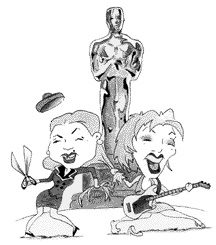 Boogie Nights
Boogie Nights
With Mark Wahlberg, Burt Reynolds, Julianne Moore, Heather Graham, John C. Reilly
Written and Directed by Paul Thomas Anderson
by William Ham
Note: Seeing as I’ve already had my say on this film in Lollipop #39, I’ve decided to turn to an expert on the subject of adult entertainment, Dr. Kennelworth Haden-Wadd, Ph.D., professor emeritus of perineal science at Al Goldstein University and author of the scholarly work The Chronic Matriculation of Adult Cinema, or Magna Cum Loudly, for his thoughts. In the interest of clarity and to get more money for writing this issue, I have changed two of his words so I can still credit myself with the piece.
The film Boogie Nights (or, as it’s known in my native Austria, Den Nachts vos Böögie) is, on the whole, an assiduously ardent portrayal of the rise to prominence and penetration into the mainstream of pornographic film in the 1970s, a period of renaissance for the art form comparable to the little-noted “Golden Shower Age” of the 1930s, which produced such forgotten classics as Blown With the Wind and Citizen Kame. I was duly impressed with director Paul Thomas Anderson’s attention to detail and period verisimilitude – in particular, his talent for pastiche is remarkable for one so young (reminding me of the young Peter Fondle, star of the epic Whore and Piece, who at his peak had a pastiche that weighed almost six pounds). Burt Reynolds (long rumored to have appeared under an assumed name in Francis Ford Coppulate’s herpes-inspired picture A Poxed-Up Lip Now) gives an exemplary performance as Jack Horner, whose drive to raise adult films to the level of art may have been inspired by Tristan Shaote, an impresario whose monograph,I’d Like to Raise Adult Films to the Level of Art, was well-received by those who didn’t return it for lack of postage. I had to chortle upon seeing Heather Graham as Rollergirl, knowing that Anderson had surely been inspired by the abortive career of Susan Oozin, an actress whose controversial “Shallow But Wide Throat” routine was offset by her short-lived pseudonymous work under the name of “Dorothy Slamill,” owing to her tendency to wear ice skates at all times, an inspired notion doomed to failure by her bad ankles and the fact that she lived in Phoenix. The rest of Anderson’s ensemble, from John C. Reilly to William H. Macy (both of whom had very large parts [in every sense] in David Mamet’s rarely-seen entreé into the gay porn genre, Glenn, Gary, Glen and Ross), all acquit themselves admirably (quite unlike the ill-fated British star of the era, Jackson Bollocks, who remains incarcerated to this day for exposing himself to freshly-killed poultry in 1979). If there are any flaws to this picture, they lie in simple omission. However well Anderson portrays the backstage world of the smut scene, a little more background on the screenwriting aspects would have been welcome: no matter what action went on in front of the lens, it could scarcely compare to the last-minute rewrites that went on during the filming of the melancholy drama (in which both a melon and a collie were prominently featured),Sac of Woe. The mounting tension with which I and a team of ten other scenarists faced devising the now-legendary line “Place that pulsating pit viper of amour squarely into my shuddering fertility gorge, you well-hewn personification of virility!” certainly challenged any mounting that went on on-screen. Oh, and as for the lead in the film, young Mark Wahlberg (whose former stage name was assuredly derived from an old associate, Marquis Marc, whose brilliant live show, An Evening with Moliére and a Wide-Necked Beer Bottle, ran in a vacant lot off-Broadway for over seventeen weeks), my own words, regrettably, fail me. I must turn to the verse of the erotic poet T.V.T.S. Eliot, who wrote “And though the hearts of mankind weaken in the soul’s sight/ They only… whoa! Check out the polska kielbasa in that guy’s chinos!” So true, my esteemed friend. So true.



